Site menu:

January 2011 Newsletter
Black-tailed Godwits.
Cheshire and Wirral Bird Report 2009.
December Bird News.
Forthcoming Events.
Latest Newsletter.
Colour Ringed Black-tailed Godwits - Part 3
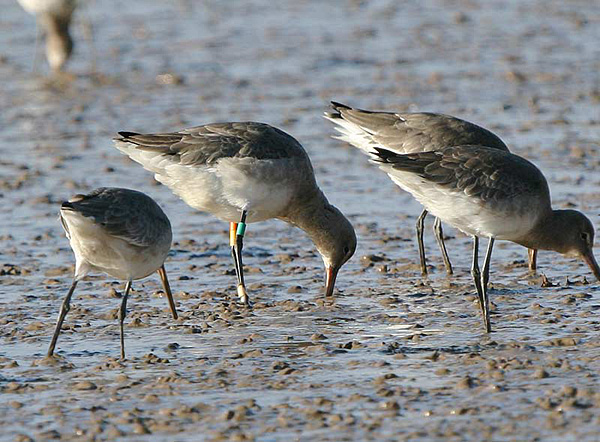
Ringed on the Wash in 2005, recorded in Iceland (May 2006), Marshside (Jan and Mar 2008), Fen Drayton (Feb 2009) as well as on the Dee Estuary on several dates between Jan 2006 and Feb 2009.
This is the third in a series of articles about
Black-tailed Godwits (Icelandic race, Limosa limosa islandica), including those which are colour ringed. The first
article was published in Dec 2006 and
the second in
Dec 2008. Since 1st
Dec 2008 we have had 802 sightings of 54 colour-ringed Black-tailed
Godwits, not a bad total! During the course of this article I'll be using
codes for the colour rings - see details at the end of the article but most
are fairly obvious, e.g. G = green, Y = yellow etc.
As you can see below the Icelandic race of Black-tailed Godwits are ringed in several locations. As you might expect most seen on the Dee Estuary were ringed in Iceland, both as chicks and adults. Many are also ringed on the Wash, a lot are ringed in France and Portugal but these birds which spend the winter to the south of us only pause in this country for a short while on their way to and from Iceland so we don't tend to record many of them.
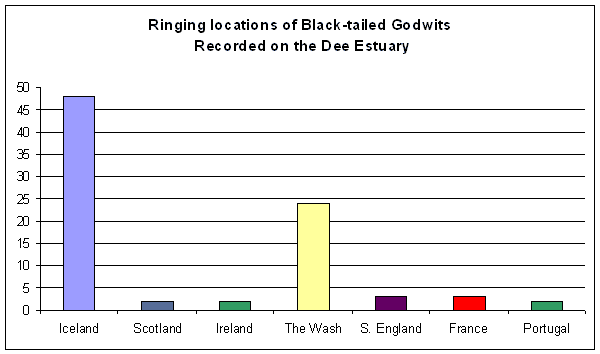
Most years the Dee Estuary is the second or third most important site in the country for this species, with the Wash the most important and the Thames Estuary vying with the Dee for second place. Within the Dee the area off Connah's Quay and Flint is by far the most important, in October 2009 5,500 were here with similar numbers in 2010. By November birds tend to disperse with typically up to 2,000 at both Point of Ayr and Thurstaston. The most numerous sightings of colour ringed birds come from Thurstaston through the winter, here many of the birds feed close to the beach and it is relatively easy to note the rings. The fresh water sites at Gilroy Nature Park (West Kirby) and Inner Marsh Farm are important during the migration periods. July to September is the time when we see birds which have just arrived from Iceland after the breeding season, many of these then go on to spend the winter much further south in France and Portugal. Two of the first birds back at Inner Marsh Farm this summer were colour-ringed, both observed on Jul 9th. YR-LGflag was ringed on the Tagus Estuary in Portugal on Nov 18th 2006 and has been seen there every winter since, but this was the first record away from Portugal apart from one record in Iceland. Similarly, NO-mOflag was ringed on the Atlantic coast of France on Nov 8th 2007 and seen there during the following two winters, but had never before been recorded away from France.
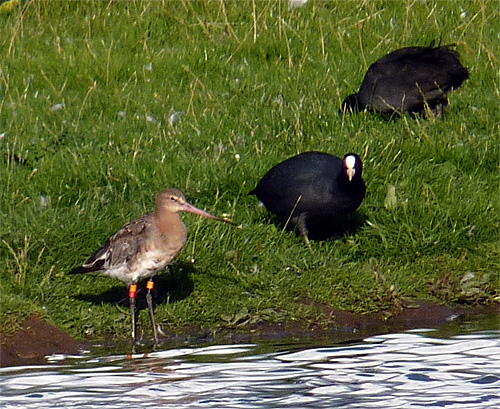
This bird spent most of Aug 2010 here. Ringed in Iceland Jun 2005, also seen in the Dublin area
in May and Dec 2006, and Mar 2010. Previously seen at Gilroy in Oct 2008 and Sep 2009.
Gilroy (West Kirby) has become an increasingly important site over the past couple of years with a spring max of 717 in March 2009 and late summer max of 800 in August 2010. Gilroy is a very good spot to see ringed birds although it can be frustrating at times as the birds spend a lot of time roosting on one leg in deep water! This year the reserve was visited daily through August; the first birds back from Iceland didn't arrive here until a month after the first ones at Inner Marsh Farm, but then built up rapidly as shown in the graph. Gilroy is obviously an important stop over for juveniles as by the time numbers had reached 100, on Aug 11th, 50% of the flock were juvs with the rest being mainly adults in breeding plumage. This ratio stayed more or less the same until about the 25th when there appeared to have been an influx of non-breeding adults and consequently the percentage of juvs went down to 36%. Numbers reached a max of 800 on the 30th then dropped to just over 500, numbers remained at the 300 to 500 level for the following few weeks until birds started staying on the estuary in late October. A total of nine ringed birds were seen at Gilroy during late summer and early autumn this year.
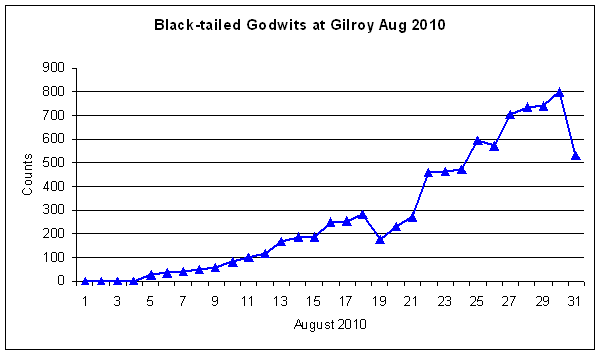 You are no doubt curious as to the purpose of Operation
Godwit (otherwise known as Project Jaðrakan) and what it has achieved. Rather than repeat what others have
already said can I point you to a couple of very informative and
interesting websites:
You are no doubt curious as to the purpose of Operation
Godwit (otherwise known as Project Jaðrakan) and what it has achieved. Rather than repeat what others have
already said can I point you to a couple of very informative and
interesting websites:
http://www.scoiliosaefnaofa.com/God%20history.html and
http://www.uea.ac.uk/~b026515/index.html.
The map below gives an indication of the sort of information we get about the birds we see. OR-WR was ringed as an adult in northern Iceland in July 2005. We can then follow it's movements through 2006 and up to February 2007 when it ends up on the Stour Estuary in Essex. It appears that it was either a failed or non-breeder in 2006 as there was only a gap of five weeks between when it was seen at Skinflats and when it turned up on the Ythan Estuary. If it did breed in Iceland in 2006 it must have been one of the last to arrive and one of the first to leave! There was then quite large gaps between the records (hence the dashed lines); after visiting Portugal in early 2008 it then turned up at Marshside RSPB (Southport) over a year later before being seen on the Mersey Estuary in March 2010. The next record is at Inner Marsh Farm on Jul 23rd 2010, a fairly typical return date for birds flying back from Iceland. Unusually this bird has only been recorded once at all the sites it has been seen, most birds tend to stay at a site for several days, if not weeks. It is also the only bird on our Dee Estuary records which has been recorded on the nearby Mersey Estuary.
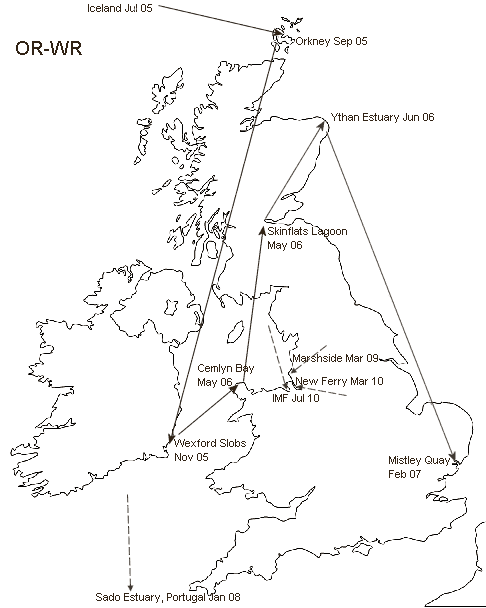
The following convention and codes are used when
describing the colour rings:
Left leg comes before right, and top rings come before bottom. Nearly all
birds have four rings although there are exceptions, for example we have
seen a bird with six rings and see below an example of a three ringed bird. A flag is a ring with a tab, so Rflag is a red
ring with a flag (which is also red). Most rings are on the tibia (i.e. above the
knee), sometimes a single ring can be on the tarsus (i.e. below the knee)
and these are shown as //, so //R is a red ring on the tarsus.
B - Blue
G - Green
L - Light Green (often referred to as Lime green, this colour can look light blue or grey, depending on
light conditions, in bright sunlight can look white).
O - Orange
N - black
R - Red
W - White
Y - Yellow
B= - a long blue/green ring with two horizontal black stripes.
W= - a long white ring with two horizontal black stripes.
8 - number 8 on a white ring.
X - letter X on a white ring (other numbers and letters could be used in
future).
m - metal 'BTO' ring, these are smaller than the colour rings but they can
look white in bright sunlight.
Some ring combinations are illustrated below:

YR-LG
RG//W-R BW-NOflag
R8-GG OY-B=
A key to the ring combinations used by the different Godwit ringing groups can be downloaded at http://limosa.no.sapo.pt/Key.html.
Please submit your sightings either to myself by
(I have
contacts with the people doing the ringing and will pass on any feedback)
or via the normal channels such as the BTO Website - but I would be very
grateful if you could forward any feedback for birds seen on the Dee
Estuary to add to the ever growing Dee Estuary database. Experience has
shown that it is always wise to double check the ring combination - it is
so easy to get the legs the wrong way round, or miss a ring on the tarsus,
or just write them down wrong!
Many thanks.
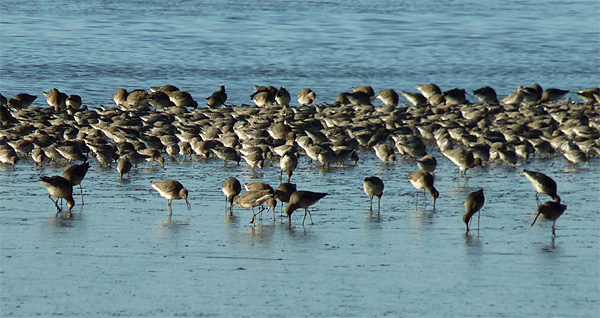
Acknowledgements
1. "Operation Godwit - Project Jaðrakan", all those 'Blackwit' enthusiasts who
do the ringing and subsequent data compilation, and who are so prompt at
sending out details to people who send their records in, key people are:
Tomas Gunnarsson and Vigfús Eyjólfsson in Iceland; Jenny Gill, Graham
Appleton, Pete Potts and Ruth Croger in UK; Becca and Jim Wilson in Ireland;
Guillaume Gelinaud and Julien Gonin in France and Jose Alves in Portugal.
Also the Farlington Ringing Group and University of East Anglia play an
important part.
As well as being actively involved in ringing many of the above, and others, have written and/or
contributed to various publications regarding Black-tailed Godwits - see
http://www.uea.ac.uk/~b026515/publications.html.
2. I have obtained colour ring information for birds recorded on the Dee Estuary from various sources, I would like to thank in particular my fellow Dee Estuary colour ring enthusiasts: John Jakeman, Matt Thomas, Steve Hinde, Chris Butterworth and Charles Farnell.
3. Most counts of Black-tailed Godwits on the Dee Estuary and Gilroy were carried out by myself and other local birders, other data was obtained from the North-East Wales Bird Report 2009 and WeBS Report 2008/09.
Cheshire and Wirral Bird Report 2009
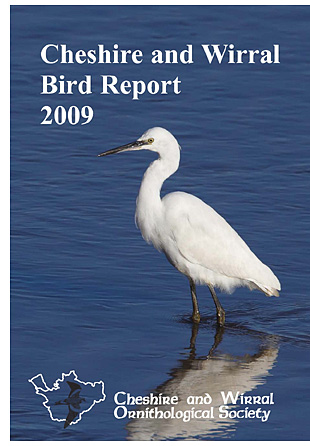 We’re delighted to say that the annual Bird Report for
2009 is now available.
The
eye-catching colour front cover this year is of a Little Egret, an
increasingly common sight in Wirral. The 200 pages of text include 81 maps,
graphs and tables, and 18 beautiful illustrations from two different
artists. As usual, the colour map of the county forms the centre spread of
the Report. A total of 17 colour photographs, which best capture some of the
highlights of the year, are spread over seven full pages.
We’re delighted to say that the annual Bird Report for
2009 is now available.
The
eye-catching colour front cover this year is of a Little Egret, an
increasingly common sight in Wirral. The 200 pages of text include 81 maps,
graphs and tables, and 18 beautiful illustrations from two different
artists. As usual, the colour map of the county forms the centre spread of
the Report. A total of 17 colour photographs, which best capture some of the
highlights of the year, are spread over seven full pages.
As usual, this year’s Bird Report is full of interesting articles:
• The discovery of a Paddyfield Warbler was just reward for the dedication
of the observers and ringers on Hilbre.
• A description of the first proven breeding of Cetti’s Warbler in Cheshire,
which is the most north-westerly breeding record yet.
• Whilst another article recalls the excitement of finding a Terek Sandpiper
on the Dee estuary on the incoming tide.
• The incredible coincidence of discovering a Stone Curlew in the same
field, and on the same date 21 years later.
• Serin is seldom caught for ringing in the UK, so this exceptionally rare
species to the north-west region, was an amazing find in the nets at
Woolston Eyes NR.
• The story of finding a Ring-necked Duck, after it was spooked by a
fireworks display in Staffordshire.
• An account of a remarkable influx of Short-eared Owls onto the Dee
estuary.
• A fascinating description of visible migration at Hale Head during autumn
2009, which was quite the most exceptional over the past 30 years.
• The results of a census of Rooks in Cheshire and Wirral, undertaken during
2009.
• Finally, the Breeding Bird Survey (BBS) has now been running for 16 years,
sufficient to identify county population trends for many species.
All the ‘regulars’ are there: ‘Weather and Bird Review of the Year’; the
full ‘Systematic List of Birds Recorded in Cheshire and Wirral during 2009,
including ‘Category E Species’; ‘Early and Late Dates for Migrants’; ‘BBRC
and County Rarities Decisions’; ‘Ringing Report’; ‘Chairman’s Review’;
‘Database Statistics for 2009’ and finally, advice on the ‘Submission of
Records’.
Last, but not least, we have again included a Species Index at the back to
help you quickly look up your favourite species. This will be particularly
useful to those not familiar with the new Systematic List order now adopted.
Andrew Duncalf, 25 Monarch Drive, Northwich, Cheshire, CW9 8UN
Tel: 07771 7745210 Email: andrewduncalf@cawos.org
December Bird News
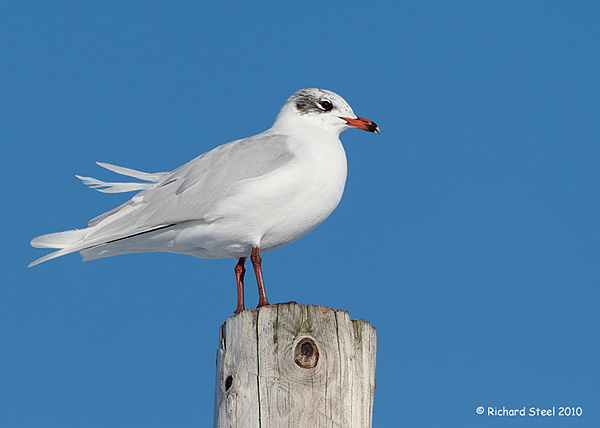
The big story of the month was the exceptional cold weather. I know not everyone shares my view but I loved it! It was just fantastic to be out birdwatching on those crisp, sunny and windless days when everything was covered in snow - in our mild maritime climate snow and daytime freezing temperatures are rare events. See the series of photos, showing various icy scenes, below.
West Kirby Marine Lake froze over for the first time since 1980. First it froze for a couple of days early in the month, then for a week from 20th to 27th. Before it froze for the second time we had very good numbers of duck with max 34 Goldeneye (7th), 26 Tufted Duck (20th) and 52 Red-breasted Mergansers (20th). The count on the 20th was carried out in the morning, by the afternoon the lake was covered in ice and that night the min temp reached -17C at nearby Crosby! As you can see below several hundred waders roosted on the ice on the Marine Lake, no doubt it was no colder than standing on the frozen shore. At both Hoylake and West Kirby shore birds could be seen roosting on ice which had been lifted by the sea as the tide came in.
At Hoylake Knot numbers were impressive, max 25,500 on the 6th. On the same date there were 890 Bar-tailed Godwits here. A max of 760 Bar-tailed Godwits feeding at low tide on Thurstaston Shore all month was exceptional, most winters we rarely get more than 150 here. More usual here are the Black-tailed Godwits which reached a max of 2,150 on the 15th. Also at Thurstaston there were great views of several hundred Pintail, max 1,047 on the 10th, and Teal, max 424 on the 18th.
The cold weather brought in an influx of Woodcock, I received 12 reports including birds feeding in gardens, highest number was of four at Leasowe Castle on Christmas Eve. There were reports of many hundreds of Skylarks on the marshes, by far the largest number was 3,000 on outer Burton Marsh on the 19th. Probably our best winter yet for Waxwings continued. They were ever present in Neston with a max count of 30. There were also 18 in Greasby, 25 in Heswall and 16 in Parkgate, with smaller numbers elsewhere. There were lots of reports of Bramblings, including a flock of about 200 over West Kirby.
These days the Scaup is quite a scarce species in our area. It was good to see some around last winter but this winter they seem to be much more numerous including a flock of 72 off Meols on the 22nd followed the next day with 82 off Hilbre. Brent Geese reached a maximum of 171 on Hilbre. On a mirror like sea 515 Great Crested Grebes were counted off Hilbre on the 5th, no doubt the same flock which featured in last month's newsletter. Pink-footed Geese are now a regular feature on the marsh off Parkgate and 600 were present through the month. Several hundred were also feeding with the swans on Shotwick Fields and there was a report of 1,000 at Heswall although these may have been birds flying through. Bewick's Swans reached over 100 for the first time for a few winters with 109 on the 27th, 79 Whooper Swans were present on the 10th.
Rarer birds included a Lapland Bunting on Heswall Shore between 19th and 22nd, a Cetti's Warbler showing well at Parkgate on the 22nd and a Great Grey Shrike in Newton on the 24th - unfortunately the latter wasn't reported until several days later.
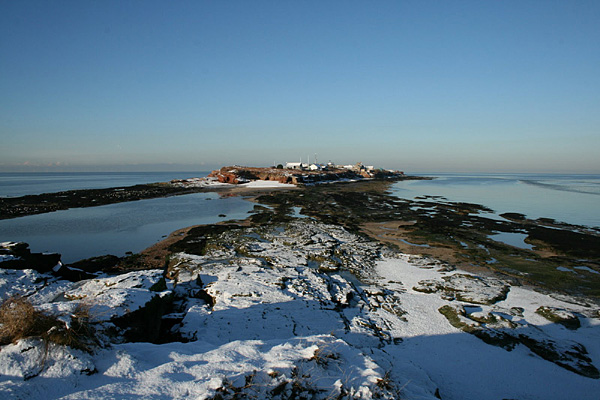
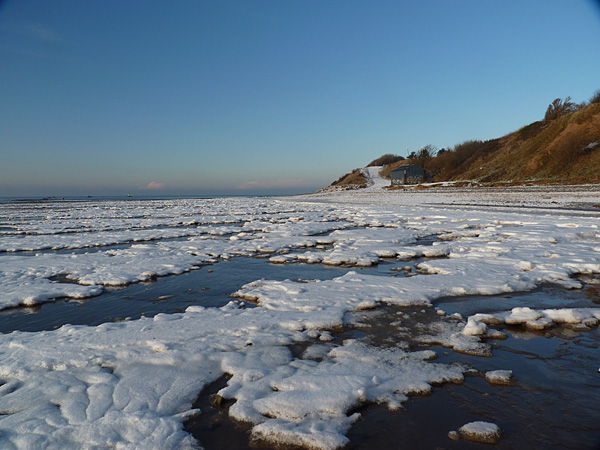
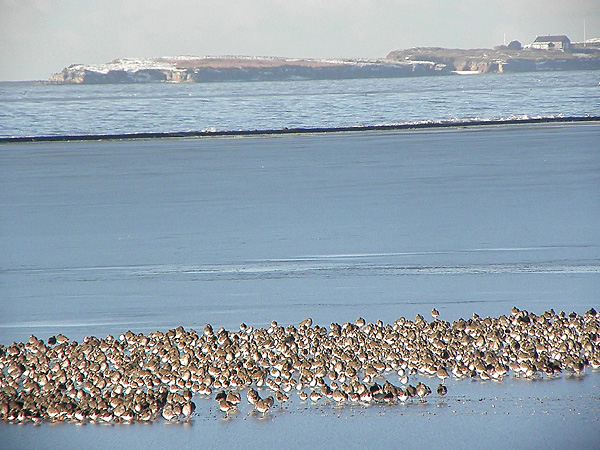
© Mike Davenport.
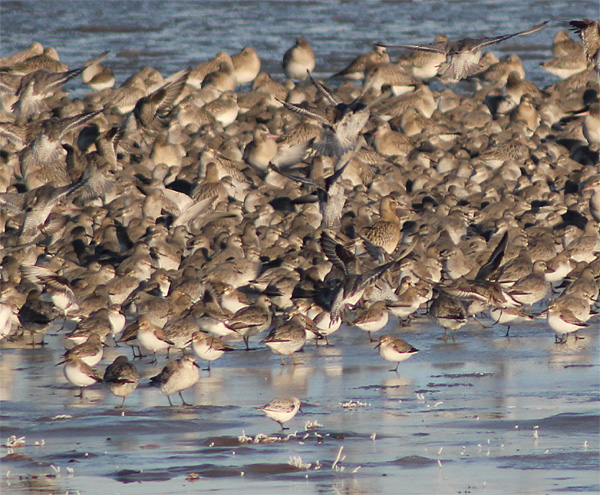
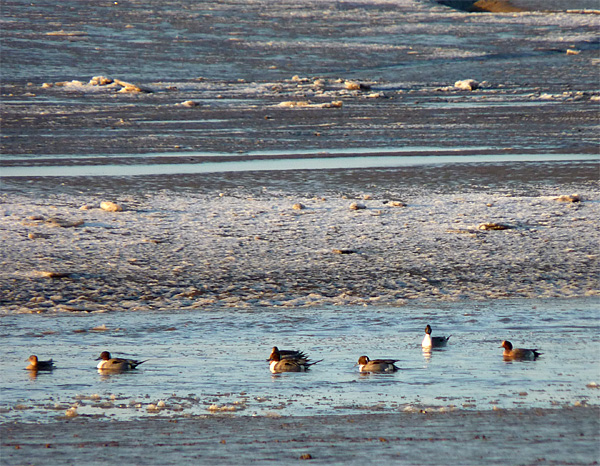
Richard Smith.
What to expect in January
The big unknown for this month is whether the cold spell will return as this will undoubtedly have a big effect on the birds. The coldest period early in 2010 was during January and we saw a big influx of Woodcocks, Redwings and Fieldfares - we've seen plenty of Woodcocks but nothing like the numbers of the 'winter thrushes' we got last winter. We have seen plenty of Bramblings and Waxwings so far this winter and no doubt plenty will still be here through the month. There must also be a good chance of seeing both Lapland and Snow Buntings.
There may well be very good numbers of waders, particularly Knot, to be seen at their high tide roosts at Hoylake, West Kirby and Point of Ayr - the former usually being the best location. Thurstaston can be a great place to se them at low tide, sometimes feeding on the mud just a few feet from the beach, along with many Black-tailed Godwit, Dunlin, Pintail and Teal. This winter there are also exceptional numbers of Bar-tailed Godwits here, mostly north of the causeway. Purple Sandpipers are likely to increase through the month - Hilbre is always good for this species but the pontoon on New Brighton Marine Lake is an excellent spot to see them at high tide, as are the rocks by the Lifeguard Station at Wallasey Shore. Some years there is a winter peak of Spotted Redshanks with at least six at Inner Marsh Farm, and at the Connah's Quay and Oakenholt reserves.
With high numbers of Brent Geese already present in December we could get over 200 this month. Some years there appears to be a large influx of these geese with exceptional numbers lasting only for a day or two - often seen around Little Eye, West Kirby Shore and Bird Rock (Red Rocks) at high tide. By mid-month Pink-footed Geese start their return passage from north Norfolk to Lancashire, if we are lucky we can see hundreds of them moving north over the estuary - a fantastic sight.
Forthcoming Events
January Highest Spring Tides (Liverpool)
Also see
Tides page.
21st January, 12.00hrs (GMT), 9.8m.
22nd January, 12.42hrs (GMT), 9.9m.
23rd January, 13.26hrs (GMT), 9.9m.
Forthcoming Events
Organised by the
Wirral Ranger Service ,
Flintshire Countryside Service and/or the RSPB:
All these events and walks have bird interest, even those not advertised
specifically for birdwatching. No need to book for these events unless
specified - please check below.
Also see 2011 Events Diary.
Saturday, 1st January 9am-dusk, Inner Marsh
Farm Big Year.
What better way to start a big year for IMF than to have a go at a “Big
Year” and try to see as many species of birds as possible? You never know,
you could end up adding a new record to the impressive 230 birds already
seen on this part of the reserve. Raise money for conservation and have fun
- Get your checklist and see if you can you beat the RSPB staff?
Saturday 8th January, 1:00pm - 2:30pm, A Woodland Walk in
Royden Park.
An in depth look at Royden Park’s woodland, its beauty, uses and wildlife.
Meet at the Ranger’s Office, Royden Park.
No need to book. For further enquiries ring:- 0151 677 7594.
Wednesday 12th January 10am - 12.30pm, The
Thurstaston Circle.
A guided birdwatching walk with Wirral Ranger Service looking for winter
specials from the Visitor Centre along Thurstaston Shore, across Heswall
fields and back via the Wirral Way to finish at the Centre. It's sure to be
muddy underfoot so wear suitable shoes, warm waterproofs and bring
binoculars.
No need to book, meet at the Wirral Country Park Visitor Centre, Station
Road.
For more info call (0151) 648 4371
Saturday 15th January - 12.30pm start, RSPB Burton Mere Walk.
This is for anybody wanting a free guided walk around Burton Mere and
"Inner Marsh Farm 2" to find out all about the reserve extension and
development.
Booking is essential so phone 0151 336 7681 to guarantee your place or to
get further details.
Sunday 16th January, - 2.30pm start, Parkgate
RSPB Raptor Watch.
The Dee Estuary Nature Reserve is a vital wintering grounds for many birds
of prey – Discover these impressive birds in their wild habitat, hunting
and roosting on the saltmarsh. Warm clothing and binoculars are
recommended. Call 0151 336 7681 for further details.
Friday 21st January 9am start, Mud 'n' Marsh - High tide at
Heswall.
The waders and wildfowl feeding on the mudflats of the Dee are pushed
towards the Heswall Marshes by the rising tide providing a great wildlife
spectacle. Join the Coastal Rangers on Heswall Shore for a front row view
of estuary ecology in action. Make sure you have warm waterproofs and
sturdy footwear as paths may become muddy. Bring some binoculars too! No
need to book, meet at Banks Rd car park, Lower Heswall (close to Sheldrakes
Restaurant).
For more info call (0151) 648 4371.
Sunday 23rd January, 10:30am - 12:30pm, Winter Bird Walk -
Royden Park and Thurstaston Common.
A short stroll within Royden Park & Thurstaston Common to discover our
winter resident birds.
Meet at the Ranger’s Office, Royden Park. Sorry no dogs.
Please wear suitable clothing & footwear for walking through woodland and
probable muddy paths. No need to book.
For further enquiries ring:- 0151 677 7594.
Wednesday 2nd February. Point of Ayr Special, see 'poster' at bottom of the page.
Friday 4th February 9am start, Track the Tide.
Join the Coastal Rangers on a walk along
Thurstaston Shore towards Heswall following the rising tide. The rising
water will move the waders and wildfowl from their feeding grounds towards
their marshy roosts providing great wildlife-watching opportunities. Bring
binoculars and wear sturdy shoes and warm waterproofs. No need to book,
meet at the Wirral Country Park Visitor Centre.
For further ino call (0151) 648 4371.
Friday 4th February, doors open at 7.30pm for 7.45pm start, 'THE
BLACK-TAILED GODWIT’ by Dr Jennifer Gill, indoor talk at Knutsford for
CAWOS.
The talk is based on the
large-scale and long-term study of Icelandic Black-tailed Godwits over the
last 12 years. Individual colour-marking of this population, and the wide
network of volunteer observers across Europe, has allowed us to better
understand the links between habitats of varying quality, summer and winter,
with profound implications for the species.
The meetings will be held in the Cranford Suite (situated behind the
cinema), Civic Centre, Toft Road, Knutsford, WA16 0PE. An entrance fee of
£2.00 to members and £4.00 for non-members will be charged. A coffee break
is taken halfway through the evening. The doors open at 7:30pm for a 7:45pm
start (for some local background information on this study see the
Colour-ringed Black-tailed Godwits article in the Jan
2011 newsletter on this website).
Saturday 5th February, 9.30am start (HT@12.30pm, 9.3m),
Flint High Tide Bird Watch.
We will be focusing on the 1000's of waders and wildfowl coming in to roost
on this very important part of the estuary. Flocks of finches are common
feeding on seeds and last year’s twite were an excellent addition to a
thoroughly enjoyable walk across a fascinating landscape.
Phone 0151 336 7681 or email
deeestuary@rspb.org.uk for further details.
Saturday 12th February 9:00 am until 3:00 pm. Low tide Birdwatch on
Hilbre.
Join the Rangers and staff from the RSPB for a low tide visit to Hilbre
Island. Among the usual species of wading birds, we should encounter Brent
Geese, Purple Sandpipers and also good numbers of Turnstones. Warm clothing
and suitable footwear are essential. Sorry no dogs. Please book early as
there are limited places available. For booking and further enquiries call:
0151 648 4371.
Sunday 13th February - 3pm start, Parkgate
RSPB Raptor Watch.
The Dee Estuary Nature Reserve is a vital wintering grounds for many birds
of prey – Discover these impressive birds in their wild habitat, hunting
and roosting on the saltmarsh. Warm clothing and binoculars are
recommended. Call 0151 336 7681 for further details.
Saturday 19th February, Marsh Magic at
Riverbank Road, Heswall.
Join the Coastal Rangers at Riverbank Road car park in Lower Heswall for a
high tide birdwatch. With a predicted height of 10.0m the marsh could
flood, providing great views of waders, wildfowl and raptors.
Wear warm waterproofs and bring binoculars.
For more info call (0151) 648 4371.
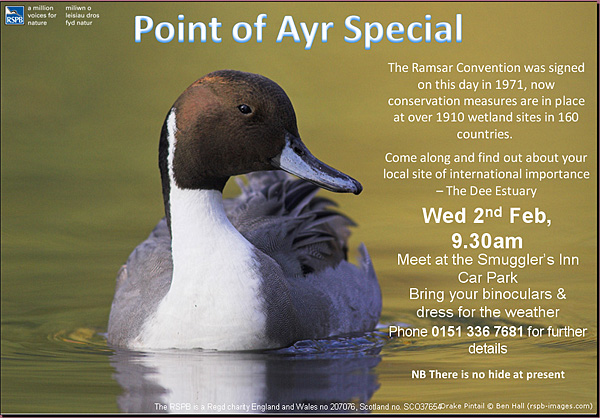
|
 |
The blank (UK) Birding Webring is a collection of quality birding web sites that are based in the United Kingdom. Visit the webring homepage for more information, or A complete list of all the sites in the webring is available by clicking here. previous site in ring : random site in ring : next site in ring |